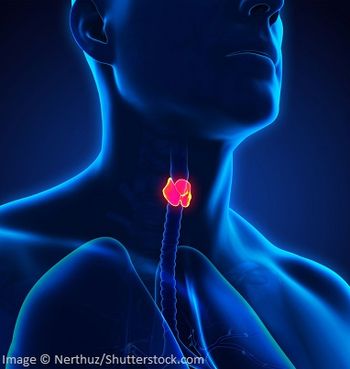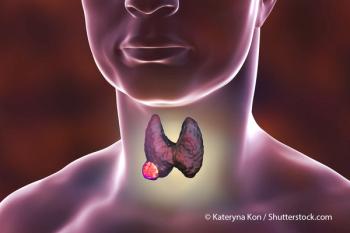
MSKCC Implementation of Active Surveillance for Thyroid Cancer
Memorial Sloan Kettering Cancer Center’s experience shows that selected patients with low-risk papillary thyroid cancer can safely defer surgery in favor of active surveillance.
The Memorial Sloan Kettering Cancer Center (MSKCC) experience shows that selected patients with low-risk papillary thyroid cancer can safely defer surgery in favor of active surveillance, attendees were told at the 86th Annual Meeting of the American Thyroid Association (ATA), held September 21–25 in Denver, Colorado.
“Our data show that an active surveillance management approach to low-risk thyroid cancer can be effectively employed in the US population,” said R. Michael Tuttle, MD, of MSKCC in New York.
“Abnormal ultrasound findings do not always require immediate cytologic diagnosis and treatment,” Dr. Tuttle said. “Abnormal cervical lymph nodes smaller than 8 to 10 mm are probably best managed with active surveillance, reserving [fine-needle aspiration] and intervention for documented disease progression.”
The past decade has brought an increasing recognition that overtreatment is a real problem in ultrasound-detected thyroid tumors, particularly for papillary microcarcinomas, Dr. Tuttle said.
“We are moving from a ‘one size fits all’ approach to a more individualized approach,” he said. “Most of us agree that biopsying these very small nodules probably does more harm than good”
Active surveillance approaches to managing low-risk thyroid cancer have been pioneered in Japan, but it was “uncertain” whether or not it would be accepted by patients in the United States, Dr. Tuttle said. MSKCC has led the effort in the United States to promote surveillance and reduce overtreatment.
As of the week of the ATA annual meeting in September 2016, MSKCC has “well over 300” patients on active surveillance, Dr. Tuttle reported. Most-85%-have low-risk papillary thyroid cancers (Bethesda VI cytology). Three-quarters of participants are female, diagnosed with a median tumor diameter of 8 mm (range, 3–22 mm), at a median age of 52 years.
At a median follow-up of 20 months, “96% continued on active surveillance without evidence of structural disease progression,” Dr. Tuttle reported. Among the six participants who experienced increased tumor diameter > 3 mm, none developed lymph node metastasis. Three of these six patients opted for surgery and two moved to community care and were lost to the program.
One challenge for implementing an active surveillance program is identifying which patients should be asked to discuss observational management instead of immediate intervention. At MSKCC, patients are carefully risk-stratified and only selected patients with very low-risk papillary thyroid cancer are approached to discuss active surveillance as a disease-management option.
Patients who agree to surveillance in most cases undergo ultrasound imaging every 6 months for 2 years, and once annually thereafter.
The ATA guidelines on thyroid cancer state that active surveillance can be considered for very low-risk tumors, Dr. Tuttle noted-but they offer little specific guidance for proper patient selection.
Patient age is one important consideration for active surveillance programs, Dr. Tuttle believes.
“The Japanese experience teaches us that patient age is significantly related to progression of papillary microcarcinomas of thyroid under observation,” Dr. Tuttle noted. “Risk of progression might be 2% if the patient is 60 years old, but 8% or 10% if they are younger.”
Implementing an active surveillance program for thyroid cancers at MSKCC, Dr. Tuttle and his colleagues quickly realized that success would hinge on buy-in from patients, referring physicians, and surgeons.
“The multidisciplinary management team makes a difference,” he said. “And there are some patients who would never consider observation.”
Dr. Tuttle was initially surprised to see patients in their 20s and 30s opt for observation instead of surgery, but noted that many young adults are using active surveillance as a “bridge” to better time treatment, because of college or work obligations.
Discussing active surveillance occurs as part of shared decision-making with patients in the context of routine clinical care, Dr. Tuttle said. Only then does the research component kick in, with patients consenting to the prospective collection of their data over time, to track program outcomes.
Molecular signatures will help decide who might benefit from observation and which patients might benefit from considering earlier intervention, Dr. Tuttle noted.
And while his program has used diameters to measure nodules, Dr. Tuttle was quick to acknowledge that volumetric imaging might offer more precise data. “Small changes in diameter do mean large changes in volume,” he said.
“We firmly believe that most papillary microcarcinomas should be followed with observation,” Dr. Tuttle concluded. “I hope that in a few years, we won’t be biopsying these small things.”
Reference
1. Tuttle RM, Minkowitz G, Wong R, et al. Oral abstract 6. Successful implementation of an active surveillance management approach to low risk papillary thyroid cancer in the United States. Thyroid. 2016;26(suppl 1).
Newsletter
Stay up to date on recent advances in the multidisciplinary approach to cancer.















































































